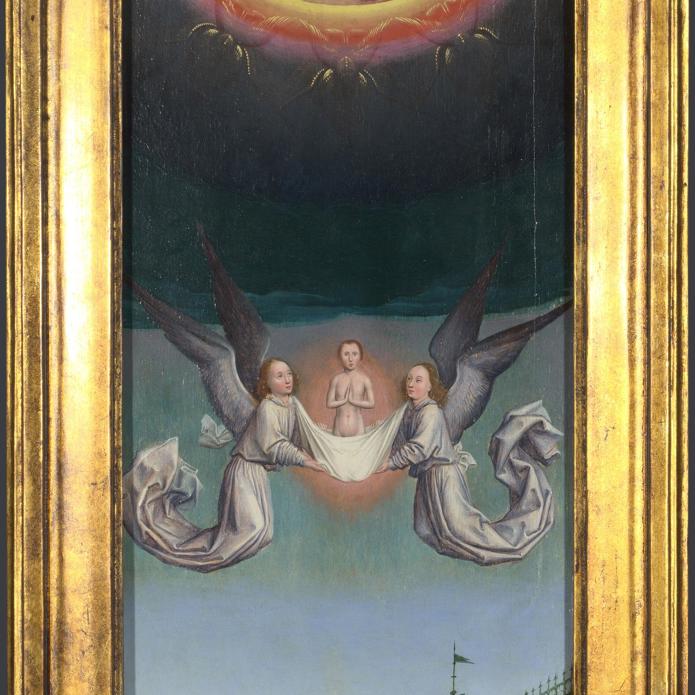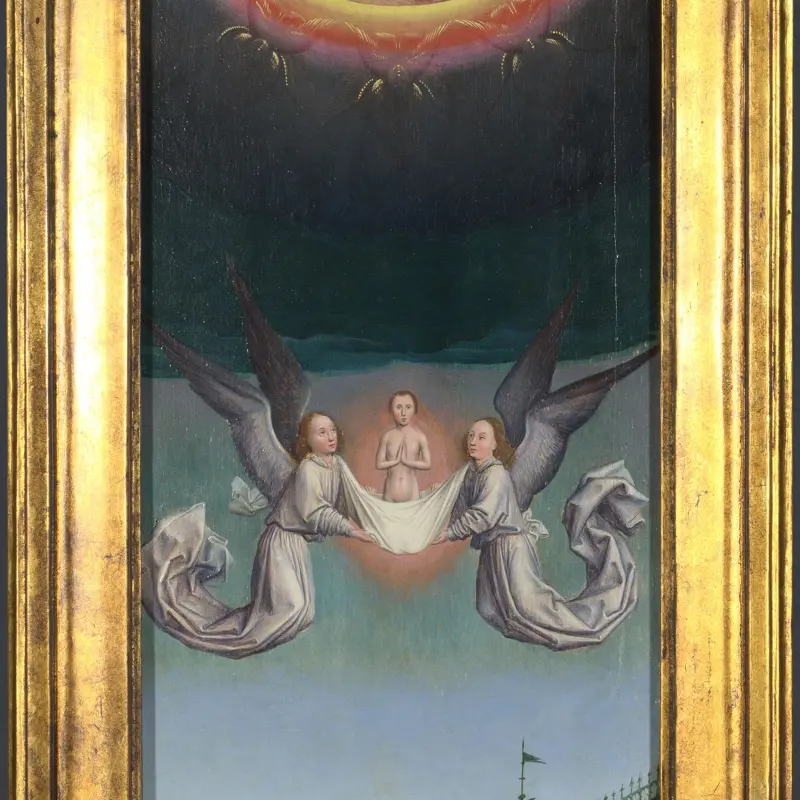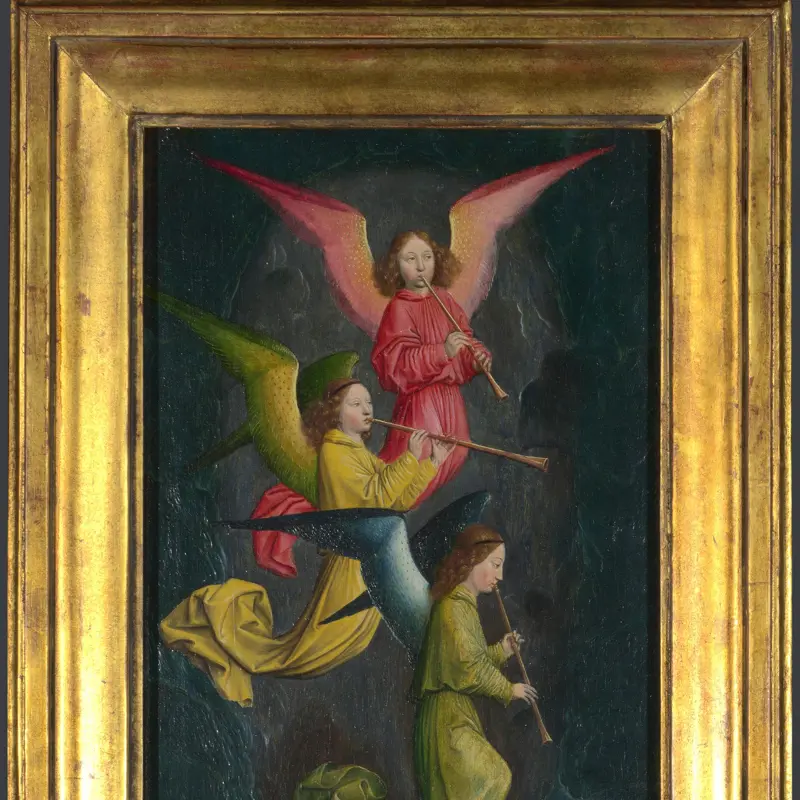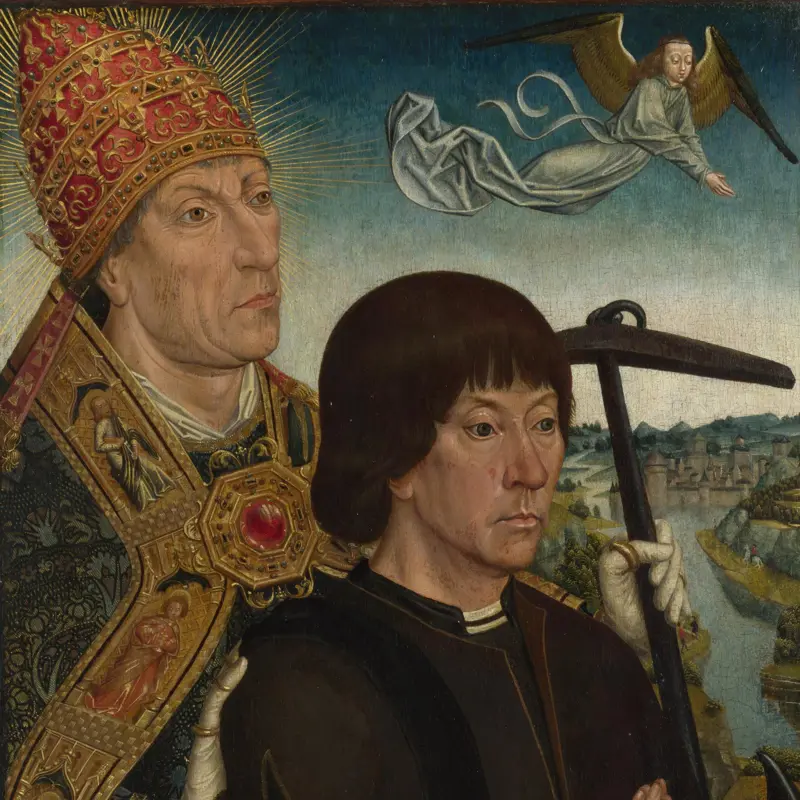Simon Marmion, 'The Soul of Saint Bertin carried up to God', about 1459
About the work
Overview
Two angels carry a small, naked figure upwards. Below is part of a roof; above, God the Father sits on a Gothic throne, ringed by angels with multiple wings. This is the top part of the right wing of an altarpiece that stood on the high altar of the Abbey of St Bertin in Saint-Omer, northern France.
The naked figure is the soul of Saint Bertin, whose death scene originally appeared immediately below. On the back, the top part of a Gothic stone canopy is painted in grisaille (in shades of black, white and grey), identical to that on the other wing, A Choir of Angels. When the wings were closed, the canopies would have have covered up the gilded silver Crucifixion in the centre of the shrine.
Key facts
Details
- Full title
- The Soul of Saint Bertin carried up to God: From Right Hand Shutter
- Artist
- Simon Marmion
- Artist dates
- Active 1449; died 1489
- Part of the series
- Fragments of Shutters from the St Bertin Altarpiece
- Date made
- About 1459
- Medium and support
- Oil on wood (probably oak)
- Dimensions
- 57.7 × 20.5 cm
- Acquisition credit
- Bought, 1860
- Inventory number
- NG1302
- Location
- Room 52
- Collection
- Main Collection
- Frame
- 20th-century Replica Frame
Provenance
Additional information
Text extracted from the ‘Provenance’ section of the catalogue entry in Lorne Campbell, ‘National Gallery Catalogues: The Fifteenth Century Netherlandish Schools’, London 1998; for further information, see the full catalogue entry.
Exhibition history
-
2017Monochrome: Painting in Black and White.Museum Kunstpalast22 March 2018 - 15 July 2018
-
2022Between Hell and Paradise: The Curious World of Hieronymus BoschSzépművészeti Múzeum7 April 2022 - 17 July 2022
Bibliography
-
1945Davies, Martin, National Gallery Catalogues: Early Netherlandish School, London 1945
-
1955Davies, Martin, National Gallery Catalogues: Early Netherlandish School, 2nd edn (revised), London 1955
-
1970M. Davies, The National Gallery, London, Les Primitifs flamands. I, Corpus de la peinture des anciens Pay-Bas méridionaux au quinzième siècle 11, Brussels 1970
-
1987Davies, Martin, National Gallery Catalogues: The Early Netherlandish School, 3rd edn, London 1987
-
1998Campbell, Lorne, National Gallery Catalogues: The Fifteenth Century Netherlandish Paintings, London 1998
-
2001
C. Baker and T. Henry, The National Gallery: Complete Illustrated Catalogue, London 2001
Frame
This frame was made in 1991 at the Gallery. Made from pinewood and water-gilt, it has step mouldings and an ogee leading to the sight edge.
Inspired by early Italian styles, this double-sided frame was made for the opening of the new Sainsbury Wing.
About this record
If you know more about this work or have spotted an error, please contact us. Please note that exhibition histories are listed from 2009 onwards. Bibliographies may not be complete; more comprehensive information is available in the National Gallery Library.
Images
About the series: Fragments of Shutters from the St Bertin Altarpiece

Overview
These two paintings – The Soul of Saint Bertin carried up to God and A Choir of Angels – were once the upper parts of the wings of an elaborate altarpiece that was made for the high altar of the abbey church of St Bertin at Saint-Omer in northern France. It was commissioned by Guillaume Fillastre, Abbot of St Bertin, and was consecrated in 1459.
The wings are thought to have been painted at Valenciennes, where Simon Marmion was almost certainly the leading painter; he had moved there from Amiens between 1454 and 1458. The main parts of the wings are now in the Gemäldegalerie, Berlin. On the inside these show Fillastre himself with scenes from the life of Saint Bertin. The central section is known only from written descriptions, but was in the shape of an inverted ‘T’ and was made of gold, gilded silver and copper, rock crystal, diamonds and other precious stones.



